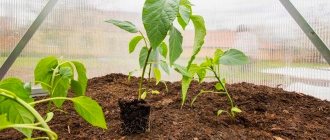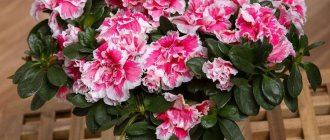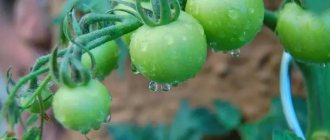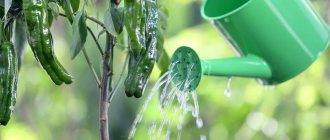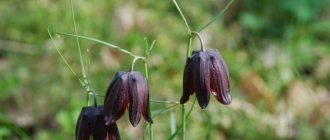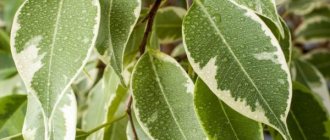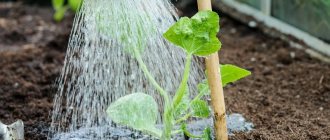Dracaena is an exotic and decorative “palm” of the Asparagus family, which grows on average up to 15 centimeters upward per year. People call it the dragon tree.
Dracaena is native mainly to Africa, southern Asia and Central America.
The plant is evergreen with a smooth, straight trunk, its appearance is very similar to a palm tree. The leaves are narrow and long with sharp tips. The leaves are green only in the upper part of the stem; in the lower part they gradually dry out and fall off. An indoor palm grows up to a maximum height of 50 centimeters.
There are several varieties of home dracaena:
- marginata;
- bamboo of happiness;
- fragrant.
In order for a plant to decorate the interior, it needs proper care:
- most types of palm trees are unpretentious and grow well in a room with high humidity (in summer the room temperature should be from 20 to 25 degrees, in winter it should not fall below 15 degrees);
- The plant loves daylight, but direct sunlight should be avoided. A good location is a west or east window. In winter, dracaena needs additional lighting;
- Any soil is suitable for good growth; it is best to place drainage in the pot;
- avoid drafts and cold rooms;
- in the summer you can put it on the balcony;
- do not forget to replant the plant on time. Once every three years (young shoots once a year, an adult palm once every five years).
Recommendations for watering dracaena
How to water dracaena correctly?
- During the growth period, it is watered once a week.
- In winter, it is recommended to irrigate the soil twice a month.
- Soften the water before watering with alkaline acid.
- To prevent the plant from growing upward, cut off the top.
- Remove yellowed leaves.
The secret to good growth and beautiful greenery of dracaena is ideal care; the soil should not be dry or too damp.
Signs of overwatering or dry soil
Dry leaf tips indicate a lack of moisture in the air, and not infrequent watering. If the owners, instead of frequently spraying the flower, grab the watering can, there is a great danger of root rotting.
Dracaena needs to be watered more often when it shows the following signs:
- leaves drooping;
- the tips turn yellow;
- the plates curl - so, if you water rarely, the area of evaporation decreases;
- many lower leaves fall off (not to be confused with natural aging);
- the color of variegated varieties fades;
- the soil lags behind the walls of the pot;
- When watering is done, the water immediately flows into the pan.
Signs of overwatering:
- dark spots appear on the leaves;
- the plates hang as if they are dry, but become soft;
- the earthen lump is wet and smells bad;
- the color becomes faded, it seems that the leaves are covered with dust;
- the root rots;
- the base of the trunk softens - this is the last stage, you need to trim and plant the top.
Watering dracaena at home should be done carefully. In hot weather or in the sun, overdrying of the substrate is more dangerous; at low temperatures in the shade, overmoistening is more dangerous.
How to properly water dracaena at home
You need to water with pre-settled water, the water temperature should be room temperature or a little warmer.
Attention! It is forbidden to water with cold water in winter, as there is a high probability of death.
In addition to standard watering, palm trees need shower baths. Experts recommend carrying out the procedure twice a month. Such irrigation promotes freshness, cleans leaves from dust and improves the appearance of the plant.
In winter, when the air is dried out by radiators, you need to irrigate the indoor flower with a spray bottle.
Water application regime at different times of the year
The regime for adding water to dracaena may vary depending on the time of year and room temperature.
in winter
Reference. Since winter is a period of rest and a kind of hibernation for dracaena, during which it gathers strength for active growth in spring and summer, you should not get too carried away with watering at this time.
- If the air temperature in the room where the plant is located does not exceed room temperature, then you can add water to the soil once every seven days. Don’t forget about the leaves of the flower - wipe them with a damp cloth.
- If the apartment is too hot, then watering can be increased. You can add water every 3-4 days and additionally spray the plant with a spray bottle.
In summer
In summer, watering dracaena should be more intense than in winter. The warm season is a period of active growth and flower formation, so water needs to be added to the soil every 1-2 days:
- You can combine standard watering through the top and bathing in the shower if the temperatures are too high.
- Under no circumstances leave the plant in the sun or draft (especially after “bathing”). Dracaena can burn the leaves or become hypothermic and die.
- Before adding a new portion of water, make sure that the soil is sufficiently dry. Also, do not forget about loosening the substrate (a crust on the surface can lead to waterlogging and rotting of the roots).
How much water is needed to water dracaena at home?
You need enough water to saturate the entire soil from top to bottom of the pot.
Watering methods:
- above. With this method of watering, the spout of the watering can must be carefully placed on the edge of the pot so that water flows out of it in a slow stream. Once you see water in the pan, the process is over. After ten minutes, remove the water from the pan. This method is easy and convenient, but it quickly washes out minerals from the soil, so it requires constant feeding of the soil with mineral fertilizers. It is necessary to feed only in the evening (to avoid burning) and during the growth period - from March to August;
- below. It is necessary to pour water into the pan so that the water covers the bottom of the pot no more than 1 centimeter. This method is suitable only when the soil in the pot is dry and gradual moistening is required;
- bathing. The pot is immersed in water and removed after complete absorption, after which it is taken out and left until the excess water is gone. This method is suitable for the summer; experts do not advise taking risks in winter. Also, do not water young palm trees using this method.
How to water a plant indoors?
Reference. Dracaenas are excellent air purifiers in the home. They saturate it with oxygen, give residents positive emotions, and relieve tension.
But in order for this plant to delight you with its bright green foliage, you need to carefully follow the watering regime at home. Any changes in soil or air moisture can lead to disease or death of the plant.
How often should this be done?
Watering too frequently can lead to waterlogging of the soil and rotting of the root system of the plant. The average interval between liquid applications is 4-8 days.
The watering regime in winter and summer will be different. So, in winter the frequency of soil moisture is reduced, but in summer (especially in drought and heat), on the contrary, they can increase.
If the air in the house is already too humid, then you can water the plant less often. You should not place containers with flowers near radiators, radiators and other heating devices. They dry out the air, and dracaena cannot tolerate this.
The interval between watering may vary depending on the type of plant. For example, species with wide leaf blades require more frequent application of water. Narrow-leaved varieties like a small amount of liquid, often added to the soil.
How many times a week?
Typically, watering dracaena is carried out 1-2 times a week, depending on the time of year, the microclimate in the room and the moisture content of the substrate. As soon as the soil in the pot begins to dry out at a depth of 4-5 cm, it means that it is time to add a portion of water.
You can also focus on the condition of the sheet plates. If the plant needs moisture, the tips of the leaves begin to dry out.
Important! If there is an excess of water, the leaves will become sluggish, soft, and lose their brightness of color.
What water is best to use?
Water for dracaena must be left to stand for at least 48 hours. At the same time, its temperature should not be lower than room temperature (ideally it should be 21 degrees). If you water the plant with cold water, the soil will become supercooled and the roots will rot.
Choose water with a minimum amount of foreign impurities. The alkaline balance should be neutral. Both rain and melt water are suitable for irrigation. You can slightly acidify it if necessary with table vinegar or peat tablets. Hard water can be softened with oxalic acid
You can spray the plant only with warm water and in no case chlorinated. It is better to filter it first to avoid troubles.
Process technology
Watering dracaena can be done using three methods:
- through the top;
- into the pallet;
- in the shower.
Through the top
In order for watering using this method to be effective and the liquid to saturate all the soil in the container, you need to pour in the water slowly, leaning the spout of the watering can against the edge of the pot. To prevent useful elements from being washed out of the substrate, you need to choose watering cans with a narrow spout and, accordingly, a narrow watering stream.
Attention! You can tell that the soil is saturated by whether water is flowing into the pan or not yet. After the water begins to flow down, stop watering and leave the plant for 30 minutes. Then drain off the excess water.
To pallet
If the substrate in the container is too dry and begins to peel off from its walls, then you need to use the method of watering into a pan:
- Pour water into the tray under the container. Through it, the plant roots will absorb the required amount of liquid.
- Leave the water in this container for a while until the earthen ball with the flower is completely saturated with moisture.
This method should not be used too often, since frequent use can lead to the accumulation of harmful salts in the soil.
In the shower
This watering method is usually used in the summer. The air temperature in the room should not be lower than 25 degrees:
- Place the container with the plant in a bath filled with water. In this case, the liquid should remain at the level of the pot, but go above its edges.
- Leave the dracaena in this position until it is completely saturated with moisture (30-40 minutes).
- Water the plant from above with warm water from the shower so that dust and dirt are washed off from the leaf plates.
- Let excess water drain and make sure that liquid does not linger in the leaf axils.
- Return the flower to its original place.
When should you limit hydration?
- The frequency of watering is usually reduced after the last feeding before autumn. At this time, the interval between adding water should be at least 8-10 days.
- In winter, dracaena is completely dormant, so it is necessary to add a minimum of water. But keep an eye on the condition of the soil. Water the plant only as needed.
- Watering should be limited or completely eliminated at the first signs of overwatering (the leaves have become soft, spots have appeared on them, a putrid damp smell is coming from the pot).
The danger of improper care of dracaena
If not properly cared for, dracaena leaves begin to wilt and darken at the tips.
Mistakes when growing palm trees:
- excessive and frequent watering. Signs are rotting of the roots and trunk, magnesium spots appear on the trunk. Treatment: remove the palm tree along with the soil, wash the roots and clean off the rotten roots. Treat the roots with charcoal solution and place them in new soil. It should be watered generously and not touched for two weeks;
- dry soil. Signs: palm leaves dry out and fall off. Water immediately and follow the watering recommendations in the future. Remove dry ends.
- keeping in the cold. Signs: plant rotting. In this case, the palm tree cannot be saved;
- bright lighting. Signs - the leaves change color, the tips of the leaves begin to dry out and fall off. Treatment: the plant should be moved to a place where there is diffused light and begin to water slowly, gradually bringing it to normal and spray the greens.
Proper care of the palm tree, and most importantly, proper watering of the dracaena, turns the bush into a majestic and spectacular plant that will serve as a wonderful decoration for any interior. It is appropriate to install it both in an apartment, house, and in office premises.
Signs of poor hydration
Dracaena is extremely sensitive to watering regime.
Any violations immediately affect her condition. Symptoms of improper water application:
- the leaf blades have drooped, drooped, the tips have dried out and turned yellow (lack of water);
- leaves curl, some elements fall off, become dull (lack of moisture);
- the trunk becomes soft, dark spots appear on it, a damp, putrid smell can be heard from the pot and from the plant itself, the leaves soften (overflow).
Pruning dracaena
Dracaena is unpretentious in terms of pruning. Pruning the dracaena trunk stimulates the development of lateral buds, after which the branching process begins. After pruning, the remaining part of the dracaena can be used for propagation; you can read about this here. The best time for this procedure will be spring and early summer. For pruning, choose a plant with a height of at least 30 centimeters. The cut point should be 5 centimeters below the last leaves on a plant with a bare stem. If the entire stem is covered with leaves, trim based on aesthetic considerations.
Think carefully before pruning your dracaena because the main stem will always remain this tall. If you still decide, then prepare everything you need, and this is: a sharp knife, activated carbon powder and, if possible, the Zircon preparation. Cut the stem with a knife, do not try to break off the uncut part. After cutting, treat the cut area with activated carbon powder and then with zircon. Place the cut parts in a glass of water, they will take root, and the dracaena itself in a warm place. To ensure that new shoots develop simultaneously, provide sufficient lighting. You can place the pot in a greenhouse with high humidity to speed up the growth of new shoots.
Dracaena propagation
You can begin to engage in the process of propagation of this plant at any time of the year, but experts still advise doing it in the spring - it is at this time, with the awakening of all living things in nature, that our heroine’s active growth begins. Another significant advantage is that you do not have to maintain the required temperature. But if, of course, there is no time to wait for the season, then you can do this at any time - the main thing is to maintain an optimal temperature balance. There are several ways in which a new dracaena will be “born”. Reproduction at home is easy:
- seeds;
- layering;
- cuttings.
Each of them has its own characteristics of practical implementation, which require more detailed acquaintance.
Seeds
In any specialized store you can buy dracaena seed material. Reproduction will occur according to the following algorithm:
- First, the seeds are soaked in a special growth stimulator (it is better to choose Zircon) for about a day. In this case, it is better to maintain a temperature of 30 degrees.
- After processing, the material is planted in soil for palm plants. In this case, it is best to choose disposable tableware as a container.
- The planting needs to be watered and covered with polyethylene. After this, you need to cover it with plastic and place it in a warm place (but avoid direct sunlight).
Usually this method gives excellent results - the first shoots should appear after two months. Now it’s a matter of regular watering and monthly feeding of young shoots. When the plant reaches 5 cm in height, it can already be planted in a pot.
Layering: using apical shoots
This method helps to simultaneously regulate the height of the plant (not everyone wants it to reach several meters in small apartments) and obtain a “daughter” dracaena. You need to do this:
- Treat the knife with alcohol and trim the plant itself. The resulting stump should be 6-7 cm (less than that is undesirable - the plant will simply bend).
- You can put this top in a container with warm water (you can first put an activated carbon tablet there). It is better to change the water periodically. The first shoots should be expected after about 90 days, after which they can be planted in a permanent place.
- You can plant the cut shoot in the ground. In this case, it is best to remove a couple of lower leaves. First, the end of the plant can be dipped in Kornevin powder. Land for such planting should be taken with a high peat content (usually such information is on the packaging). As for the pot, it is better to stop at a small one, no more than nine centimeters deep.
Cuttings
The plant can also reproduce using stem shoots - this is important when the top has withered. To do this you need to do the following:
- Choose a healthy and elastic plant stem with a diameter of at least two centimeters.
- Divide it into pieces 5 to 20 centimeters long (it is best to cut along leaf scars - those places where leaves are attached to the stem).
- Root the resulting cutting.
Regarding the last point, there are two ways to choose:
- When vertical, the lower part of the resulting cut is immersed in the substrate to a depth of 3 centimeters. Be sure to sprinkle a layer of sand 6 centimeters thick on top (so as not to replant the cutting in the future).
- With the horizontal type of planting, the cuttings are laid on the surface of a moist substrate and lightly pressed into it.
In both cases, a certain air and soil temperature must be observed - it should not fall below 20°C and rise above 24°C. The difference here is that in the first case only roots will form, and in the second - shoots as well. And in order to maintain optimal humidity, the plant must be sprayed regularly. The first results should appear in a month.
Dracaena disease
Although this plant is not demanding to care for, failure to comply with maintenance standards contributes to the development of parasites that can make your specimen less attractive, and may even ruin it. Here is a list of the most common pests.
- Scale insects quickly attack the plant on both sides and live on leaves and stems. After a scale insect attack, the leaves begin to turn yellow, and the dracaena slows down its growth. If measures are not taken in time, the plant will soon die. Control measures: if the plant is not severely damaged, you can wash the leaves with a soap solution mixed with vodka. If the dracaena is severely damaged, treat the leaves with Actellik. (It is better to carry out treatment with this drug in the fresh air).
- Spider mite - affects the leaves, after which they acquire a yellowish color and dry out. It starts preferentially where the air is dry. Control measures include increasing air humidity, spraying the plant, and treating with a chemical, such as Fufan.
- Thrips are tiny black insects. It settles on the leaves, moving, leaving behind silvery stains. The plant slows down its growth, the leaves become covered with spots. Control measures: treat with soapy water and wash off after 24 hours. If it doesn’t help, repeat and install an insect trap.
Where to put dracaena
Choose a bright place for the plant, out of direct sunlight.
Dracaenas with solid green leaves grow quite well in light shade. Variegated leaves need a lot of diffused light. Without it they will lose their color. Comfortable temperature for the warm season is from 20 to 30 °C. Late autumn and winter - 16–18 °C. During this period, protect the plant from the heat of radiators. For example, put wet sheets on them or install screens.
At any time of the year, protect dracaena from drafts and sudden temperature changes.
Find out all the secrets
